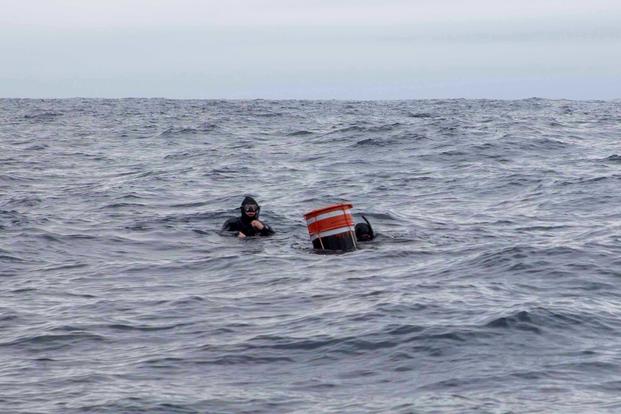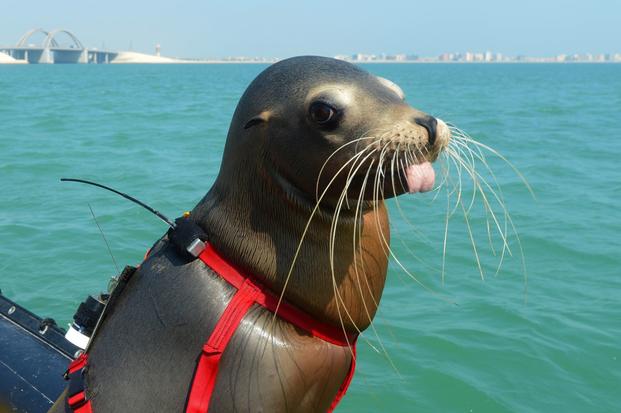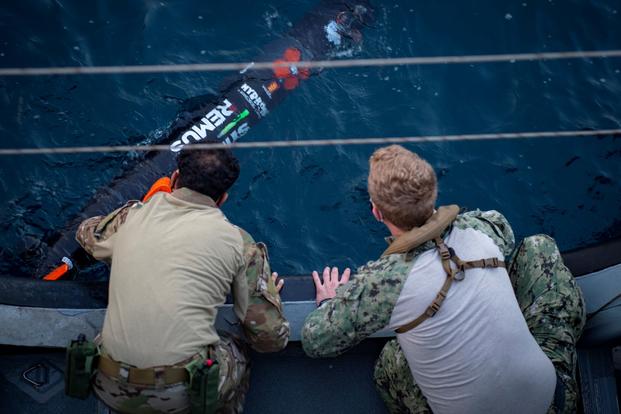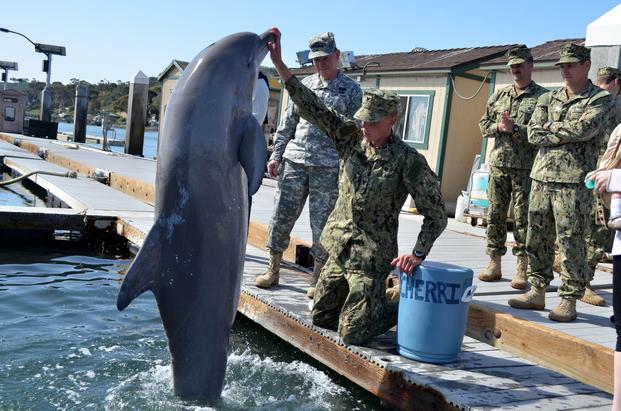Read the original article on Business Insider.
Since 1959, the U.S. Navy has trained a small force of bottlenose dolphins and sea lions to recover lost equipment, intercept intruders in ports, and detect buried sea mines.
This year, the Navy sought to end one of those marine mammals' most important missions — hunting for and neutralizing mines buried in the seabed — and use sophisticated underwater vehicles and sensors instead.
But there's a problem: That technology hasn't yet equaled a dolphin's unique ability to find mines.
So Congress balked, using the 2023 defense bill to bar the Navy from retiring its mine-detecting dolphins or ending port-security training for its marine mammals until it deploys new mine-countermeasure systems that are as good or better.
Congress' move halts the long-planned retirement of Marine Mammal Systems, a program run by Naval Information Warfare Center-Pacific at Point Loma Naval Base in San Diego.
The proliferation of high-quality, relatively inexpensive drones means that the Navy's dolphins and sea lions may soon be deactivated, but for now they remain a part of the service's mine-countermeasures systems, alongside ships, helicopters, sonars, and mobile explosive ordnance disposal (EOD) teams.
The Navy's mine-countermeasures force continues to struggle with aging equipment and is already incorporating unmanned underwater vehicles such as the Mk 18 Mod 1 Swordfish and Mk 18 Mod 2 Kingfish, which have sensors that sweep for mines and navigational hazards.
"Someday it may be possible to complete these missions with underwater drones," said Darian Wilson, a NIWC-Pacific spokesman, "but for now, technology cannot do everything the animals can do."

How it began
The first oceanarium with dolphin shows opened in St. Augustine, Florida in 1938 and featured dolphins performing tricks with fish-toting trainers.
That drew the Navy's interest. In 1959, it began work with mammals for mine-countermeasure missions and established the Marine Mammal Program a few years later. The program worked with sharks, rays, and sea turtles but settled on dolphins and sea lions.
Bottlenose dolphins are born with a biological sonar that they use to navigate and find food. Navy personnel, using food as a reward, train them to use it to locate objects that electronic sonar might miss, like mines, enemy swimmers, or lost weapons. The whiskered sea lion has keen eyesight and an extraordinary sense of directional hearing, giving it a natural ability to locate food or, with Navy training, to find mines or human intruders in the murkiest water.
While often seen at the surface, both are deep divers. Sea lions can dived 900 feet, and trained bottlenose dolphins have dived more than 1,000 feet, according to the Dolphin Research Center and SeaWorld.
That's nearly seven times deeper than most humans can comfortably do with basic scuba gear — without suffering decompression sickness. They can also zip around dense kelp beds, underwater obstacles, cluttered harbors, and busy shipping channels.
The Navy Marine Mammal Program's budget for 2023 provides $40 million for "food, medicine, veterinary care, husbandry, and facilities," Wilson said. Just over half of that — about $21 million — covers care and feeding for the program's 77 dolphins and 47 sea lions. The program employs 54 Navy civilians and six Army veterinarians, as well as 220 contractors and 22 graduate students or undergraduate volunteers.
The dolphins and sea lions work as a Marine Mammal System and train with divers or explosive ordnance disposal technicians and equipment for one of three missions, Wilson said:
The MK 5 MMS "object recovery system" are sea lions that locate and attach recovery lines to Navy equipment, like a diver's dropped tool or a training mine that then can be pulled from the water. The current budget provides about $1 million for it, half of what's needed for personnel and equipment.
The MK 6 MMS "intruder interdiction" system is dolphins and sea lions that work with security personnel to find and apprehend unauthorized swimmers or divers that could threaten ships, ports, and people. The mammals tap and tag the intruder, who then are nabbed by security sailors. The current budget funds it fully at about $7 million.
The MK 7 MMS "mine countermeasures" are dolphins working with EOD teams to find and mark mines. The dolphin drops a marker near a suspected mine, which EOD personnel or an unmanned system then neutralizes. The Navy planned to fund it with about $3.5 million for 2022 — half of what's needed. The 2023 defense bill blocks the Navy's plan to eliminate its funding next year.

The program's budget includes about $3 million for research in bioacoustics to understand how sound affects marine mammals. "We also continue to study the dolphin's natural sonar to glean lessons that might improve electronic sonar and signal processing," Wilson said.
The program has led to more than 1,200 scientific papers, and parallel research efforts, many funded by the Navy, have shed light on dolphins' built-in sonar capabilities and aided work on electronic sonar that's critical to modern naval warfare.
The Navy is one of a few military forces with marine mammal programs. (Notably, Russia has used trained dolphins to guard important naval facilities.) The US sent mine-hunting dolphins and sea lions to Vietnam in 1970, and dolphins helped guard ships in Bahrain in 1987 and in the northern Persian Gulf in 2003.
U.S. Navy dolphins have also patrolled during major public events and contribute to public safety even when not on duty: Two dolphins inadvertently found a rare, 130-year-old torpedo buried off Coronado, California while training in 2013.
Kaj Larsen, a former Navy SEAL, said he'll never forget the first time a dolphin rammed him underwater.
"The truth is, it's really one of the most effective ways to prevent attacks by combat divers, because everything else doesn't really work," said Larsen, who first experienced Flipper's furor during the dive phase of the Basic Underwater Demolition/SEAL course some 20 years ago.
BUD/S students' combat-swimmer missions doubled as anti-combat-swimmer training for the dolphins. While combat divers learn to defeat sonar nets, "we really have no way to defeat a dolphin. You're in their element," Larsen said, "and they find you every single time underwater."
Aside from brief public statements, however, the mammals' real-world missions remain classified.
"We generally do not discuss or release operational details of the Marine Mammal Program for security reasons," said Wilson who did not make program officials or trainers available for interviews, citing "ongoing program-related issues."
Mine threats remain
Sea mines, especially cheap ones, remain widely used and highly potent, whether floating freely, tethered just below the surface, or hidden on the seafloor.
Fifteen of 19 US ships sunk or damaged by enemy mines since the end of World War II were in shallow waters, said Scott Truver, a researcher, author, and mine-warfare expert. During the weeks-long Gulf War in 1991, several US warships were severely damaged by Iraqi mines.
In recent years, Iran has threatened to use its arsenal of mines to halt vital oil shipments in the Persian Gulf, and the appearance of mines in the Black Sea amid Russia's war in Ukraine has caused shipping disruptions.
Those familiar with the program say marine mammals remain an affordable option to protect ships, harbors, and ports until better tech is operational. Truver said the cost is "pixie dust compared to what we're spending on an aircraft carrier."
"The nation needs the capability to deal with buried mines," particularly as the mine threat grows, Truver said. "Houthi rebels are capable of making us have a bad day, let alone Russia and the likes."
China's navy regularly trains with sophisticated mines, Truver added, noting that "the number of mines produced and ready for deployment have grown in the last 10 years."
While opinions differ about the program's cost, few question the marine mammals' capabilities. "It is infinitesimally small [budget] compared with what has been and is being spent on a variety of other types of technology," said Scott Savitz, a senior engineer at Rand Corporation, a nonpartisan think tank.
The marine mammals "offer so much at a relatively low cost that it seems absurd not to continue to use them, certainly in the near-term," Savitz added.

The Navy expected advanced UUVs and side-scanning sonar to render marine mammals obsolete, but the technology hasn't advanced to that point. "We're always five years away from supposedly having technology that will obviate the need from having to use the mammals. I question whether we're at that point yet," said Savitz, who's worked with unmanned surface and undersea vehicles.
The Mk 18 Kingfish "has been spectacular," Truver said, "but it still can't do what a portion of what the mine-warfare Navy thinks is important for buried mines, for example."
Savitz said that dolphins and sea lions are capable of a faster "detect-to-engage" sequence than existing technologies, which use a set sequence of decisions and actions to detect an object, determine if it's a mine, and decide what countermeasures are needed. The mammals simply tap on paddles to alert their trainer or EOD handler when they find a suspected mine.
"They have great precision in being able to differentiate objects that are similar to mines or mines themselves from the massive detritus that is on the seafloor in populated areas," Savitz said, calling it "an exquisite capability that's able to overcome a lot of environmental challenges."
Dolphins "have no problem" working in strong currents, which battery-operated systems may struggle with, Savitz said. "Just as we use dogs to find drugs or explosives, there's a lot of benefit for relying on the natural ability of dolphins," he added. "We don't need to reinvent something we have a capability [for] already."
Lifetime front-line care
The dolphins and sea lions' home base are floating pens at Point Loma and three other bases on San Diego Bay and at other key Navy ports, Wilson said. Like seagoing sailors, they sometimes deploy on ships or aircraft for exercises and missions overseas.
Officials say the animals are not held captive. When working with trainers, they leave their pens almost daily and are free to swim away and not return. Stories of dolphins swimming up to nearby boaters looking for fishy treats are not uncommon.
"They get the highest-quality care available anywhere in the world" as dictated by a standing Secretary of the Navy instruction, Wilson said. "They spend their days exploring with us out on the bay here in San Diego or further offshore, in the Intracoastal Waterway down south, in Puget Sound up north, and when they aren't working, they're at home socializing with their companions."
Releasing dolphins raised in captivity — where their lifespan is usually 40 to 60 years — is a contentious issue; in the past, such dolphins have died after being introduced to the wild. If the program ends, the mammals will remain with the Navy.
"The Navy is committed to caring for our animals for the rest of their lives," Wilson said. "As our animals age, the number of animals will continue to decrease. We typically lose one or two marine mammals per year from natural causes. We have never experienced an animal casualty in combat."

Dolphins are "highly advanced" and "are perfect" for their mission, said Richard "Ric" O'Barry, an animal trainer-turned-activist and author known for his work in the 2009 documentary "The Cove."
"Their sonar makes our Navy's best sonar system" look like "a toy," O'Barry said. "That's why they were conscripted into the Navy."
A former Navy diver, O'Barry worked at Miami Seaquarium for 10 years. On his first day he captured five dolphins for the Navy. "I didn't question the orders," he said. "It seemed like a great fun thing to do."
He trained dolphins for the 1960s TV show "Flipper" before he began questioning captivity. In 1996, he and another activist were fined for released two former Navy dolphins from a marine park.
O'Barry, 83, remains active with a rescue dolphin sanctuary in West Bali, where three once-captive dolphins were rehabilitated and released in September. He believes it's time for the Navy to retire the mammals.
"I like the Navy. I've spent five of the most important years of my life in the Navy," he said. "But I don't like what the Navy does with dolphins."
Gidget Fuentes is a freelance writer based in Southern California and has reported extensively on the military including the Marine Corps, the Navy, and Pacific regional issues. Follow Gidget on Twitter.











